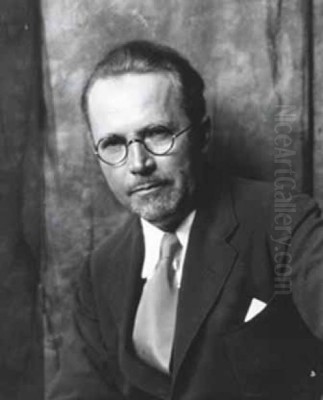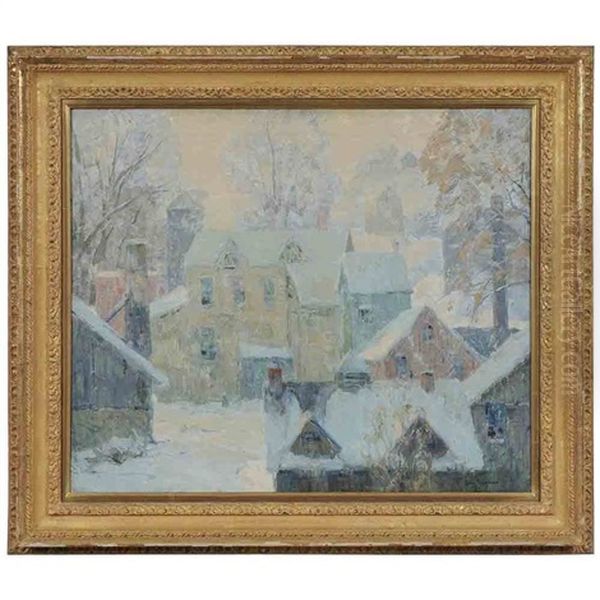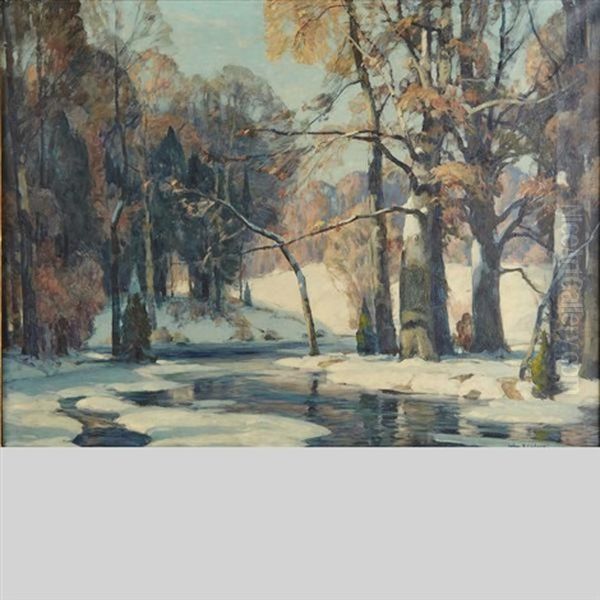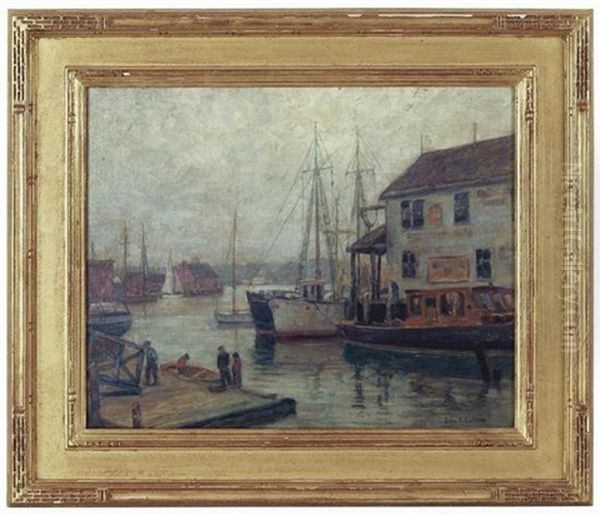
John Fabian Carlson stands as a significant figure in early 20th-century American art, celebrated both for his evocative landscape paintings, particularly his mastery of winter scenes, and for his profound impact as an art educator. A Swedish immigrant who embraced the American landscape, Carlson developed a distinctive Tonalist style that captured the subtle moods and structural beauty of nature, leaving behind a legacy of influential artwork and foundational teaching principles.
Early Life and Artistic Awakening
Born Sven August Fabian Carlson in Kolsebo, Småland, Sweden, in 1875, the artist later known as John Fabian Carlson experienced a transatlantic shift early in life. At the age of twelve, his family emigrated to the United States, settling in Buffalo, New York. This move marked the beginning of his American journey and the path toward his artistic career.
The initial years in America involved practical necessities. To support his family, the young Carlson worked during the day, reportedly as a lithographer or in the printing trade. However, the artistic impulse was strong. He dedicated his evenings to studying art, demonstrating early commitment and discipline. This period of balancing work and study continued until he was around 28 years old, at which point he was able to devote himself fully to his passion for painting.
His formal art training began in Buffalo at the Albright Art School (now part of the Buffalo AKG Art Museum). This initial instruction laid the groundwork for his technical skills. Seeking more advanced training, Carlson moved to New York City to enroll at the prestigious Art Students League, a crucible for many prominent American artists.
Formative Years: The Art Students League
At the Art Students League, Carlson encountered instructors who would significantly shape his artistic development. He studied under Frank Vincent DuMond, a respected painter and influential teacher known for his landscape work and theories on color harmony. He also learned from Lucius Wolcott Hitchcock, another notable figure associated with the League, known for his illustrative and genre work but also engaged with landscape.

Perhaps the most pivotal influence during his time at the League, and indeed throughout his career, was Birge Harrison. Harrison, a leading proponent of American Tonalism, became a mentor figure. Harrison's emphasis on mood, atmosphere, simplified compositions, and the poetic interpretation of landscape resonated deeply with Carlson. Harrison's teachings, particularly regarding the subtleties of light and color in capturing specific times of day and weather conditions, profoundly impacted Carlson's evolving aesthetic.
The Art Students League itself was a vibrant environment, fostering interaction among students and faculty who would shape American art. Carlson's time there placed him within a dynamic current of artistic thought and practice, connecting him to the lineage of artists like William Merritt Chase, Childe Hassam, and Georgia O'Keeffe, who were also associated with the League at various points.
Woodstock: A Creative Haven
Carlson's connection to Birge Harrison led him to Woodstock, New York. Harrison had begun teaching summer classes there, associated with the Art Students League. In 1906, Carlson played a crucial role on the League's Board of Control, advocating for and facilitating the relocation of the League's summer school from Old Lyme, Connecticut, to Woodstock. This move was significant, establishing Woodstock as a major center for landscape painting instruction.
Upon the school's relocation, John Fabian Carlson became its first director, serving in this capacity and teaching there for several years. His leadership helped solidify the summer school's reputation and contributed to the growth of the Woodstock art colony. Woodstock was already attracting artists, partly due to the earlier establishment of the Byrdcliffe Arts and Crafts Colony in 1902, with which Carlson also had some involvement around 1906.
Woodstock provided an ideal environment for Carlson to refine his artistic vision. Surrounded by the scenic beauty of the Catskill Mountains and interacting with fellow artists like George Bellows, Eugene Speicher, and later Yasuo Kuniyoshi, Carlson immersed himself in landscape painting. It was here that his signature style, characterized by moody, atmospheric depictions of nature, truly flourished. The forests, streams, and particularly the winter landscapes of the region became his enduring subjects.
The Tonalist Vision
John Fabian Carlson is primarily identified with Tonalism, an American art movement that emerged in the late 19th century and remained influential into the early 20th century. Tonalism stood in contrast to the brighter palettes and broken brushwork of Impressionism. Instead, Tonalist painters favored intimate, often melancholic scenes rendered in a limited range of harmonious colors, emphasizing mood, atmosphere, and spiritual resonance over objective detail. Key figures associated with Tonalism include George Inness, James McNeill Whistler, Dwight Tryon, and Alexander Helwig Wyant.

Carlson embraced the core tenets of Tonalism but developed his own distinct interpretation. His palette often leaned towards cool blues, grays, violets, and greens, particularly effective in his winter scenes. He masterfully manipulated values (lights and darks) to create depth and structure, focusing on the underlying design of the landscape. His brushwork, while often painterly, was controlled, aimed at conveying texture and form without sacrificing the overall atmospheric unity.
Unlike some Tonalists who favored twilight or misty conditions exclusively, Carlson explored various light effects, including the crisp light of a winter morning or the dappled sunlight filtering through a forest canopy. However, his primary goal remained the evocation of a specific mood – often one of quiet contemplation, solitude, or the serene power of nature. He was less concerned with literal transcription and more interested in capturing the emotional essence of a place.
Signature Subjects: Winter and Woodlands
While Carlson painted landscapes throughout the seasons, he became particularly renowned for his winter scenes. The snow-covered fields and forests of Woodstock and surrounding areas offered the perfect subject matter for his Tonalist sensibility. Snow simplified the landscape, allowing him to focus on abstract patterns of light and shadow, the graphic structure of bare trees, and the subtle color variations within whites, blues, and grays.
His winter paintings often convey a sense of profound stillness and silence. He captured the weight of snow on branches, the cold clarity of winter air, and the low angle of the winter sun creating long shadows. Works like Thawing Snow likely exemplify this focus, depicting the transitional moment when winter begins to yield, allowing for nuanced plays of light on melting snow and exposed earth.
Forest interiors were another favorite theme. Carlson possessed a deep understanding of tree structure and growth patterns. He depicted trees not just as landscape elements but almost as individual personalities, focusing on the intricate patterns of branches against the sky or the dense, shadowy depths of the woods. Paintings such as Shadowy Forest suggest this interest, exploring the interplay of light and dark within a woodland setting, emphasizing mystery and the quiet grandeur of the forest.
Masterworks
Several paintings are frequently cited as representative of Carlson's style and mastery. Thawing Snow, as mentioned, likely captures the specific atmospheric conditions and subtle color shifts of late winter or early spring, a theme allowing for rich tonal variations.

Morning Mists, Keene, New Hampshire points to his interest in atmospheric effects beyond winter. Mist softens forms, simplifies the palette, and creates a sense of mystery and tranquility, aligning perfectly with Tonalist aesthetics. This title suggests a work focused on the delicate light and veiled landscape of early morning.
The Monarch likely refers to a painting centered on a particularly imposing or significant tree, showcasing Carlson's skill in rendering arboreal forms with character and presence. Such a work would emphasize the structure and texture of the tree, perhaps set against a dramatic sky or a snowy backdrop.
Sunlit Waters indicates a departure from his more common woodland or winter scenes, suggesting an exploration of light reflecting on water. Even in such a subject, one would expect Carlson's characteristic emphasis on tonal harmony and atmospheric effect, perhaps capturing the sparkle of light through a Tonalist lens rather than an Impressionistic one.
Shadowy Forest, exhibited later in his career's retrospective appreciation, clearly points to his enduring fascination with the complex light and forms found within wooded landscapes, a subject he returned to throughout his life. These works collectively demonstrate his consistent focus on nature's structure, mood, and the subtle effects of light and atmosphere.
A Dedicated Educator
Carlson's contributions to American art extend significantly beyond his own canvases. He was a highly respected and influential teacher. After his foundational role at the Art Students League summer school in Woodstock, he took his commitment to education a step further. In 1922 (some sources state 1923), he founded the John F. Carlson School of Landscape Painting in Woodstock.
This school, which operated until 1938, became an important training ground for aspiring landscape painters. Carlson's teaching philosophy emphasized a deep understanding of nature's underlying principles – the effects of light, the structure of forms, the laws of color harmony, and the importance of sound composition. He encouraged direct observation but also stressed the need for artistic interpretation and the creation of a unified, expressive statement.
His reputation as an educator spread beyond Woodstock. He served for a time as the director of the Broadmoor Art Academy in Colorado Springs (a precursor to the Colorado Springs Fine Arts Center), bringing his expertise to artists in the American West. He also taught summer classes in other locations, including the coastal art colony of Gloucester, Massachusetts, known for its maritime subjects and association with painters like Winslow Homer and Edward Hopper.

Among his many students, Henry Mattson, another Swedish-American artist known for his moody, romantic seascapes and landscapes, stands out as one who achieved significant recognition, carrying forward aspects of Carlson's Tonalist influence. Carlson's dedication to teaching shaped a generation of painters and cemented his legacy as a pivotal figure in American art education.
"Carlson's Guide to Landscape Painting": An Enduring Legacy
Perhaps Carlson's most lasting contribution to art education is his book. Initially published in 1929 as Elementary Principles of Landscape Painting, it was later revised and reissued, most famously under the title Carlson's Guide to Landscape Painting (often dated to a 1958 republication, though based on the earlier text). Decades after his death, this book remains a classic text for landscape painters.
The guide distills Carlson's teaching philosophy and practical advice into a clear, systematic approach. It covers fundamental topics such as aerial and linear perspective, the representation of light and shadow, color theory (particularly as applied to landscape), the depiction of trees, clouds, and skies, and the principles of composition. Carlson emphasized understanding the "why" behind visual phenomena, not just copying appearances.
He famously discussed concepts like the "angles of light" and the relative values of sky, ground planes, and upright objects under different lighting conditions. His methodical breakdown of complex subjects made the challenges of landscape painting accessible to students. The book's enduring popularity speaks to the clarity of Carlson's instruction and the timeless relevance of the principles he articulated. It continues to be recommended and studied by representational painters today.
Recognition and Collections
Throughout his career, John Fabian Carlson received significant recognition for his work. He was elected an Associate of the National Academy of Design in 1911 and a full Academician in 1925, prestigious honors within the American art establishment. He won numerous awards at major exhibitions, including a silver medal at the important Panama-Pacific International Exposition held in San Francisco in 1915.
His paintings were acquired by major museums across the United States, affirming his status as a leading landscape painter of his time. Prominent institutions holding his work include the Metropolitan Museum of Art in New York City, the Art Institute of Chicago, and the Corcoran Gallery of Art in Washington, D.C. (whose collection is now largely part of the National Gallery of Art). His work continues to be featured in gallery exhibitions, such as the "Landscapes" show at the John Pence Gallery in San Francisco in 2011 and sales at auction houses like RAGO Arts.
These accolades and institutional acquisitions underscore the high regard in which Carlson's work was held during his lifetime and its continued importance within the canon of American art. His paintings are valued for their technical skill, aesthetic beauty, and evocative portrayal of the American landscape.
Context in American Art
John Fabian Carlson's career unfolded during a period of transition and diversification in American art. He emerged after the dominance of the Hudson River School painters like Thomas Cole and Frederic Edwin Church, and concurrently with the rise of American Impressionism, championed by artists such as Childe Hassam and John Henry Twachtman.
Carlson carved a distinct path aligned with Tonalism. While Impressionism focused on capturing the fleeting effects of light with bright colors and broken brushwork, Carlson and the Tonalists sought deeper moods and harmonies, often using more subdued palettes and unified surfaces. His work represents a quieter, more introspective approach to landscape compared to the dazzling canvases of the Impressionists or the grand narratives of the earlier Hudson River School.
He is often considered one of the foremost painters associated with the Woodstock art colony, contributing significantly to its reputation as a center for landscape painting. His particular focus on winter scenes also places him among the finest interpreters of that challenging subject in American art history, alongside artists like Walter Launt Palmer.
An Unusual Claim
Separate from his established artistic career, an unusual and unverified claim exists regarding John Fabian Carlson. According to some accounts, particularly within UFOlogical circles rather than mainstream art history, Carlson allegedly claimed to have had contact with extraterrestrial beings. These narratives suggest he believed he received remedies or formulas from these beings, which restored his health and formed the basis for a company he founded. He is even said to have written a book about this experience.
It is crucial to note that this story is highly anomalous and lacks corroboration within standard biographical sources on Carlson the artist. Most art historical accounts focus entirely on his painting, teaching, and published works on art. While the claim is documented in certain niche publications, it is generally viewed with extreme skepticism and is not considered a factual part of his widely accepted biography or artistic legacy. It remains an eccentric footnote, separate from his recognized achievements as a painter and educator.
Later Years and Enduring Influence
John Fabian Carlson continued to paint and teach throughout his life. He maintained his studio in Woodstock and remained an active figure in the art world. His dedication to the principles of landscape painting, both in his own work and in his instruction, remained constant. He passed away in 1947 (some sources state 1945, but 1947 appears more frequently cited in relation to his death, though his birth year is consistently 1875), leaving behind a substantial body of work and a significant educational legacy.
His influence persists primarily through two channels: his paintings, which continue to be admired for their Tonalist beauty and technical mastery, and his seminal book, Carlson's Guide to Landscape Painting, which remains an indispensable resource for artists seeking to understand the fundamentals of the genre. His work influenced his students, like Henry Mattson, and continues to inspire contemporary landscape painters drawn to atmospheric representation and traditional techniques.
Conclusion
John Fabian Carlson was a pivotal figure in American landscape painting during the early 20th century. As a Swedish immigrant who found his artistic voice in the American landscape, particularly the woodlands and winter scenes of Woodstock, he became a leading exponent of Tonalism. His paintings are celebrated for their evocative moods, subtle color harmonies, and strong compositional structure. Equally important was his role as an educator, through his directorship at the Art Students League summer school, the founding of his own influential school, and the publication of his enduringly popular guide to landscape painting. Carlson's legacy is that of a master craftsman, a poetic interpreter of nature, and a foundational teacher whose insights continue to guide artists today.